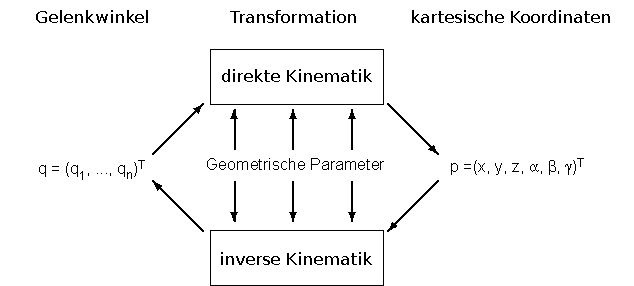Inverse kinematics
The inverse kinematics (often abbreviated as IC), inverse kinematics or reverse transformation is a term used in computer animation and robotics . It allows for a robot to determine the joint angle of the arm members based on the pose (position and orientation) of the end effector ( Engl . Tool Center Point, TCP). It thus plays an important role in the movement of industrial robots and in the computer animation of characters. It is the logical counterpart to direct kinematics .
In inverse kinematics, the last link in the kinematic chain , the so-called end effector, is moved and brought into the desired position. The remaining links of the chain must then assume appropriate positions according to the degrees of freedom of their joints.
This can be compared with the human arm , which with its joints also represents such a kinematic chain: if you bring your hand into a certain position, for example, the wrist, elbow and shoulder automatically assume certain positions. It is precisely these (joint angle) positions that must be determined using the inverse kinematics.
The following picture tries to clarify the relationships:

trouble
The following difficulties arise when calculating the inverse kinematics:
- The position of the individual links or arm elements does not have to be clear. There can (and in general also will) be several configurations that lead to the desired position of the end effector. (For example, if you hold your hand in front of your body, you can still move your elbow up or down). A sensible configuration must therefore be selected from the available options.
- Inadmissible configurations can arise. These may be mathematically correct, but the joints cannot fulfill or take them up or lead to unreachable target positions.
- The number of parameters is not the same. For example, with a 7-axis model, the joints can only be set up to one degree of freedom.
possible solutions
There is no generally applicable method for solving the inverse kinematic problem. Since the joint angles have to be calculated very quickly, solutions that are optimized and adapted to the specific robot can usually be found in practice.
The following basic methods exist:
- algebraic methods
- geometric methods
- numeric methods
Algebraic Methods
By successively inverting the Denavit-Hartenberg transformation matrices and thus solving the following system of equations, the individual joint angle vector components can be gradually calculated:
Where is a homogeneous matrix that describes the position and orientation of the end effector .
Geometric methods
From knowledge of the geometry of the robot is attempted, for example by means of cosine or sine set the joint angle vector to be calculated.
numeric methods
Numerical methods are used iteratively to try to find a solution for the joint angle vector . However, local minima or the determination of a suitable starting value are problematic here.
literature
- Dierk Lothar Hahn: Integrative multi-robot motion control for redundant kinematics , Shaker Verlag 2000, ISBN 3826569865
Web links
- Generalized inverse kinematics for applications in robot simulation and virtual reality Diploma thesis Wolfgang Smidt (PDF; 1.05 MB)
- Geometric inverse kinematics using the example of a robot with 2 rotary joints Article Jürgen Scholz (PDF; 0.08 MB)
- Backward transformation of an industrial robot on YouTube - 3D animation video for calculating the geometric inverse kinematics using the example of a 6-axis robot with an in-line wrist.


